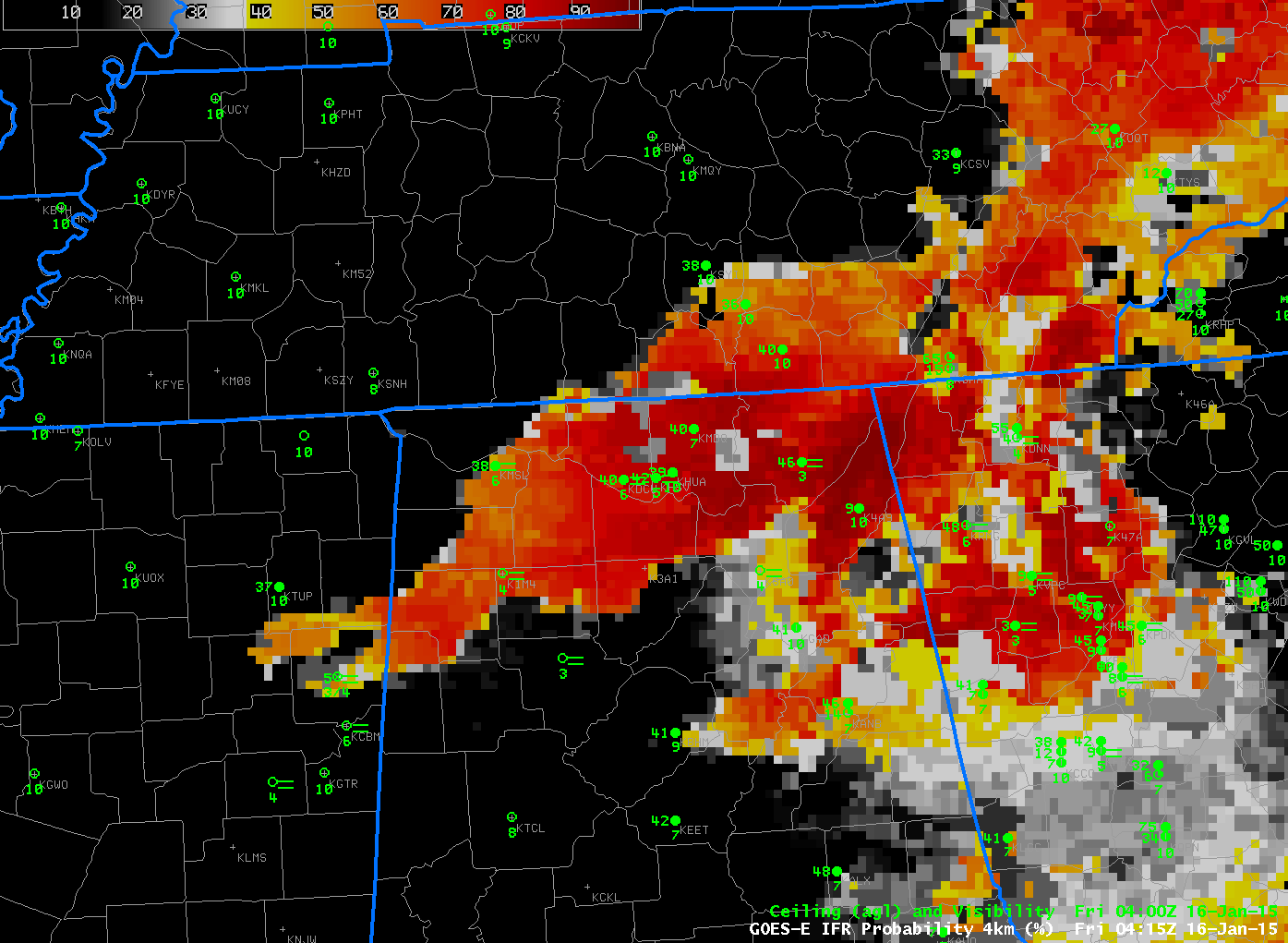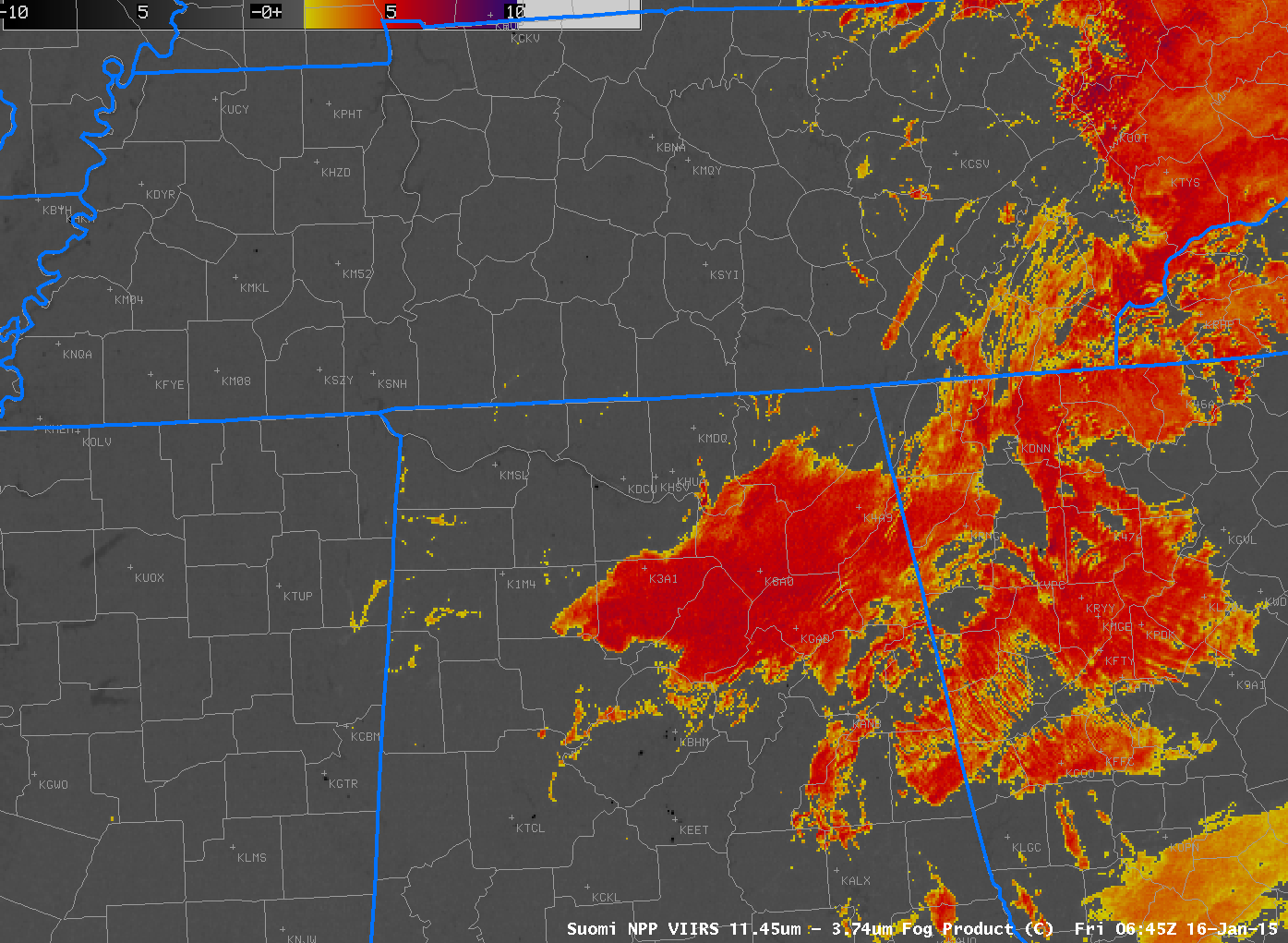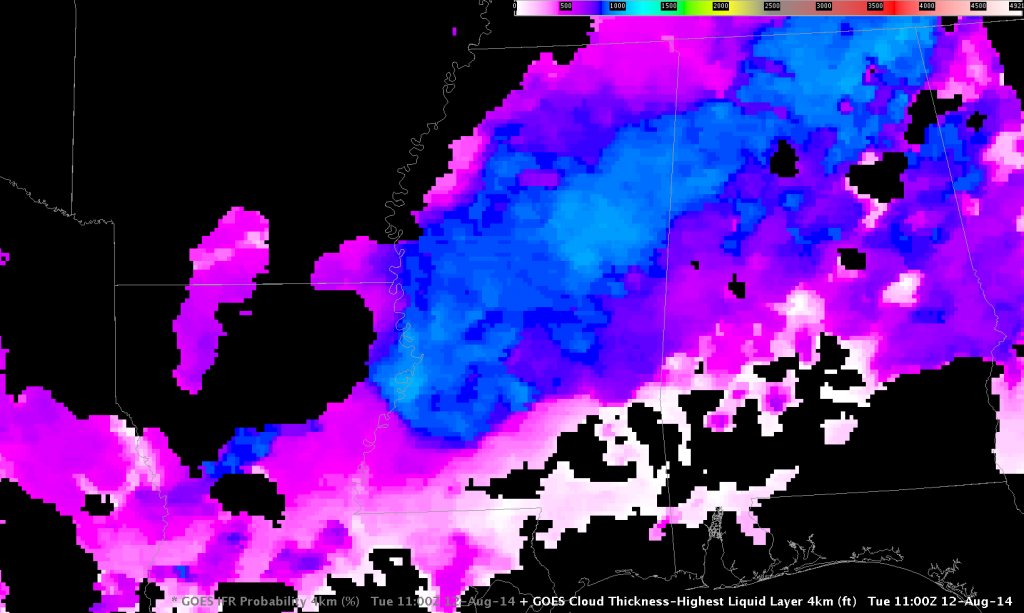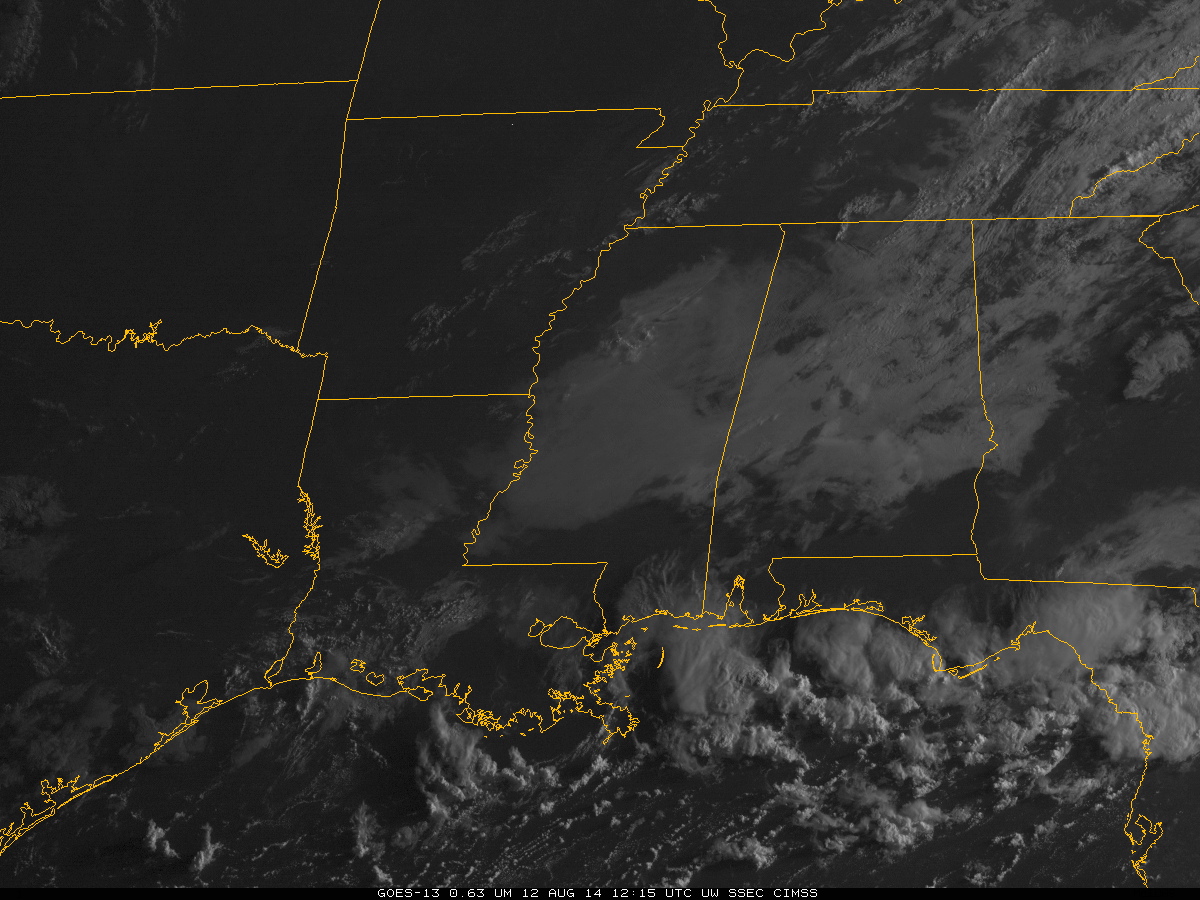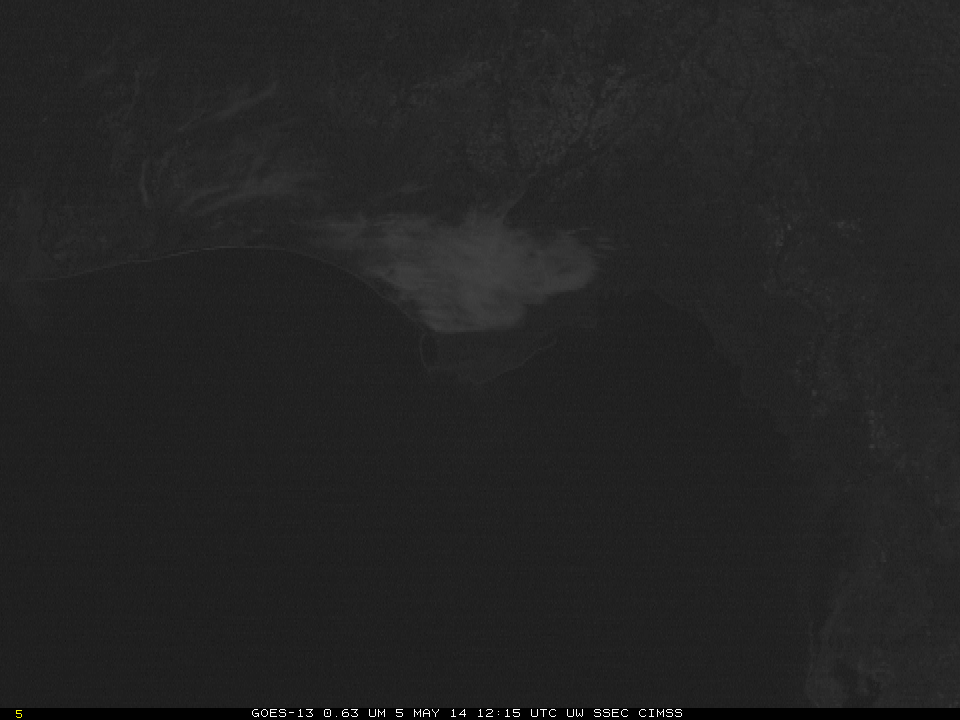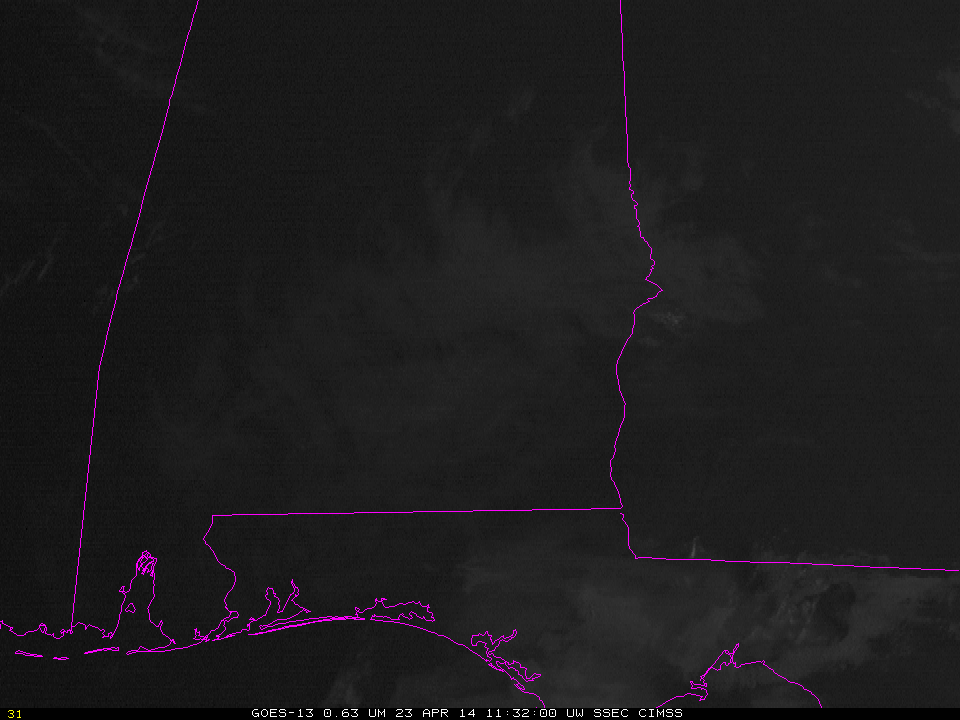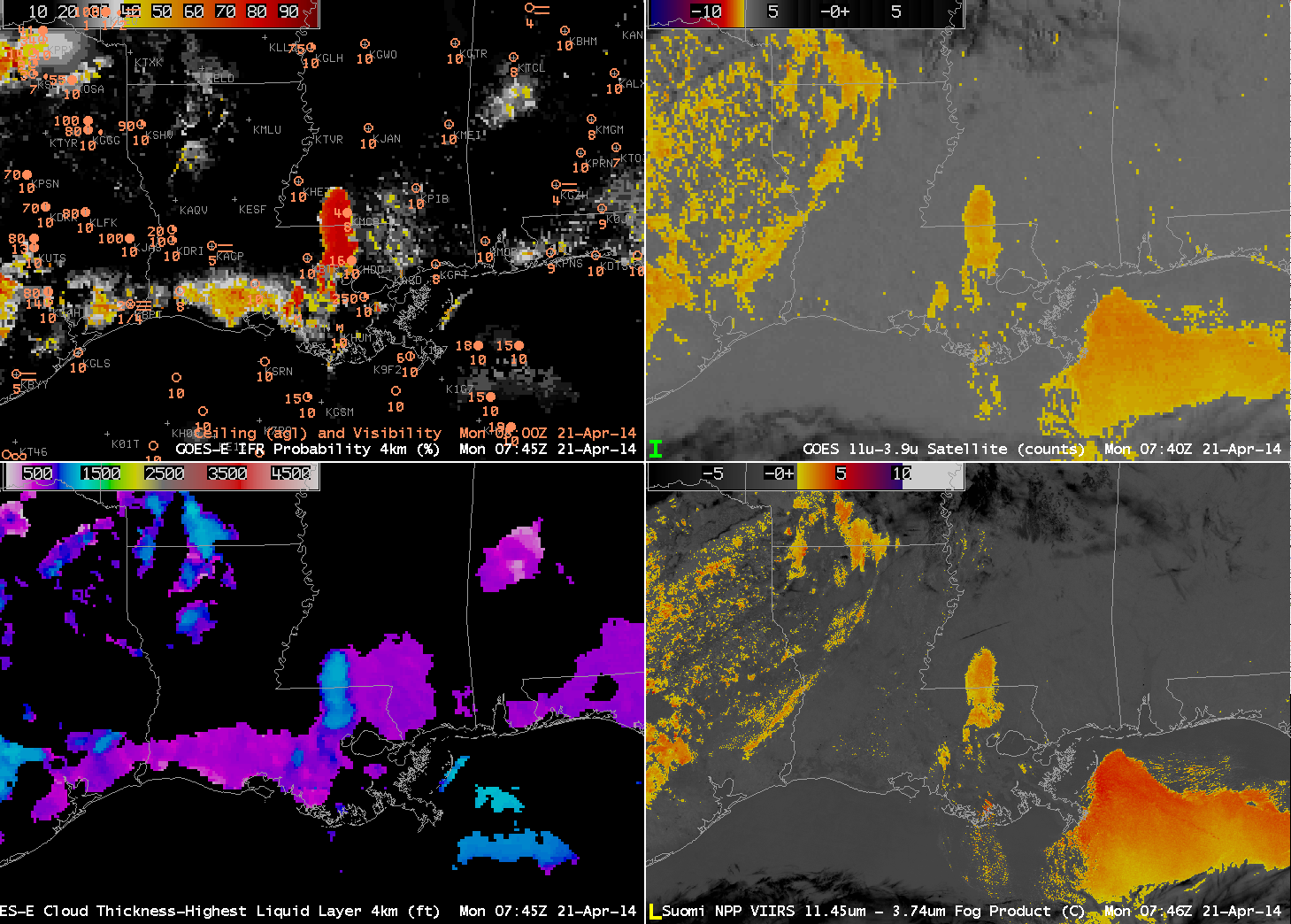Early morning March 16 2016 had another fine example of the importance of using fused information to detect regions of low clouds and fog. The animation above shows the Brightness Temperature Difference (10.7µm – 3.9µm) and IFR Probability fields from 1100 UTC 16 March 2016. A cirrus canopy over Texas and Louisiana prevents the satellite from detecting radiation emitted from lower clouds. In this region, the IFR Probability field can suggest the presence of fog/low stratus and IFR Conditions because of low-level saturation that is present in the Rapid Refresh Model. Fusing this information together allows for a better depiction of where IFR Conditions are present. Cirrus clouds are not present over Arkansas; there, both satellite and model can be used to compute IFR Probabilities. When both satellite and model suggest fog is present, IFR Probabilities are higher (over Arkansas) than when only model (over Louisiana), or only satellite, suggest fog is present.
Category Archives: Deep South
Traffic-snarling fog in Huntsville, Alabama
Dense fog developed over the Tennessee River Valley during the morning hours of 16 January 2015, causing crashes and traffic and school delays. The screenshot above (from this link), from WHNT in Huntsville, shows the conditions.
IFR Probability Fields, below, show a large stratus deck moving southward over Alabama, moving south of Hunstville by 0700 UTC. Clear skies allowed additional cooling and a radiation fog developed. The fog impeded transportation in and around Huntsville. IFR Probabilities increased around Huntsville after the large-scale stratus deck moved out, and remained high until around 1500 UTC when all fog dissipated. IFR Probability fields are computed using both satellite data and Rapid Refresh Model data. That IFR Probability is high over Huntsville and surroundings as the fog develops says that satellite data suggests water cloud development and that model data suggests near-surface saturation.
The fog was also diagnosed using traditional detection methods, such as the brightness temperature difference field from GOES-13 shown below. Brightness Temperature Difference fields detect both fog and elevated stratus, and it’s difficult for satellite data-only products to distinguish between the two cloud types because no surface information is included in a simple brightness temperature difference field.
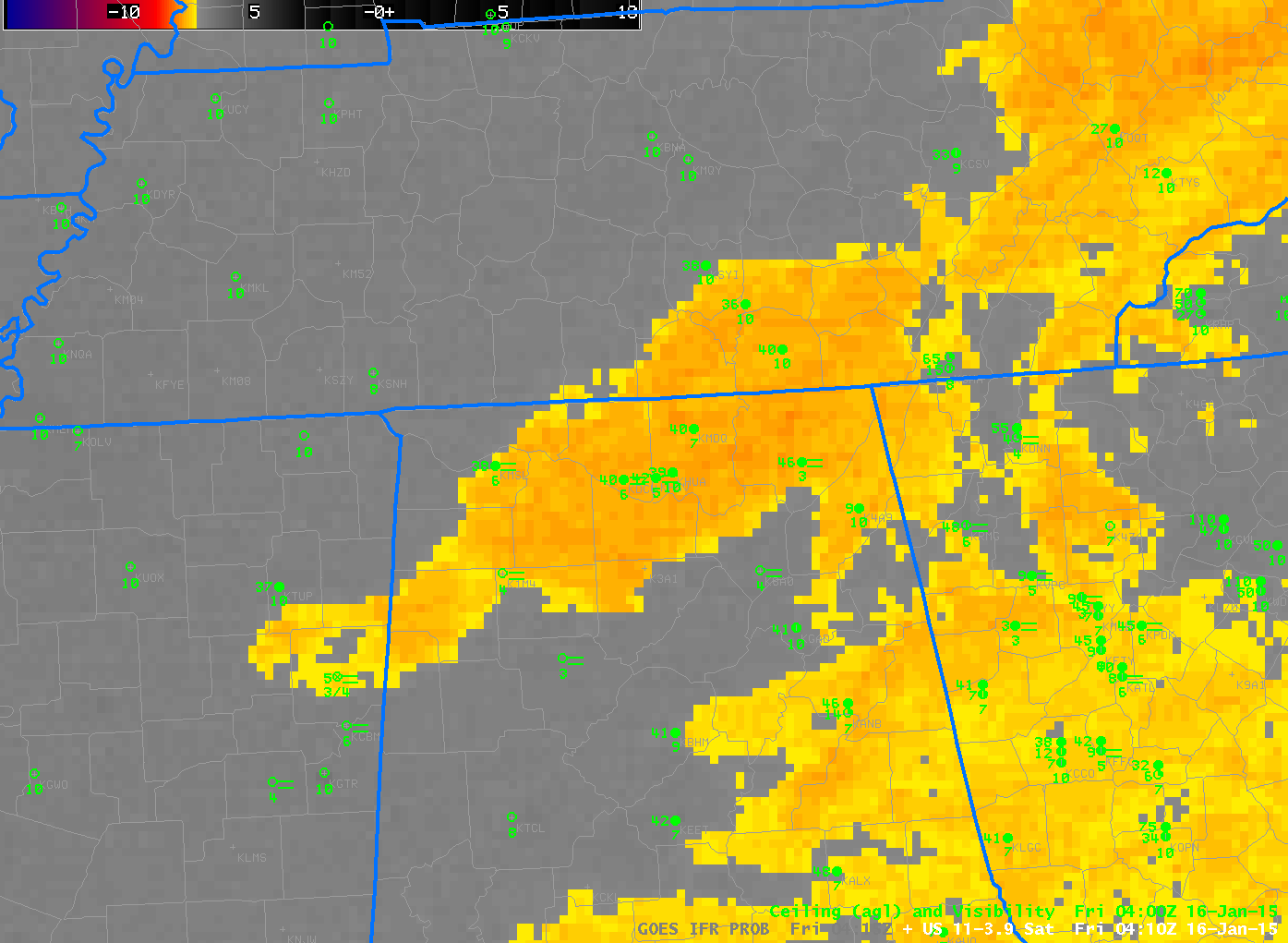
GOES-13 Brightness Temperature Differences (10.7µm – 3.9µm), half-hourly imagery, 0410-1645 UTC, 16 January 2015 (Click to enlarge)
For a small-scale event such as this, polar orbiting satellites can give sufficient horizontal resolution to give important information. MODIS data from Terra or Aqua can be used to compute IFR Probabilities, and a toggle between the MODIS brightness temperature difference field, and the MODIS-based IFR Probabilities at 0704 UTC is below; unfortunately, Terra and Aqua were not overhead when the fog was at its most dense, but a thin filament of fog/High IFR Probability is developing south of Huntsville in a river valley.
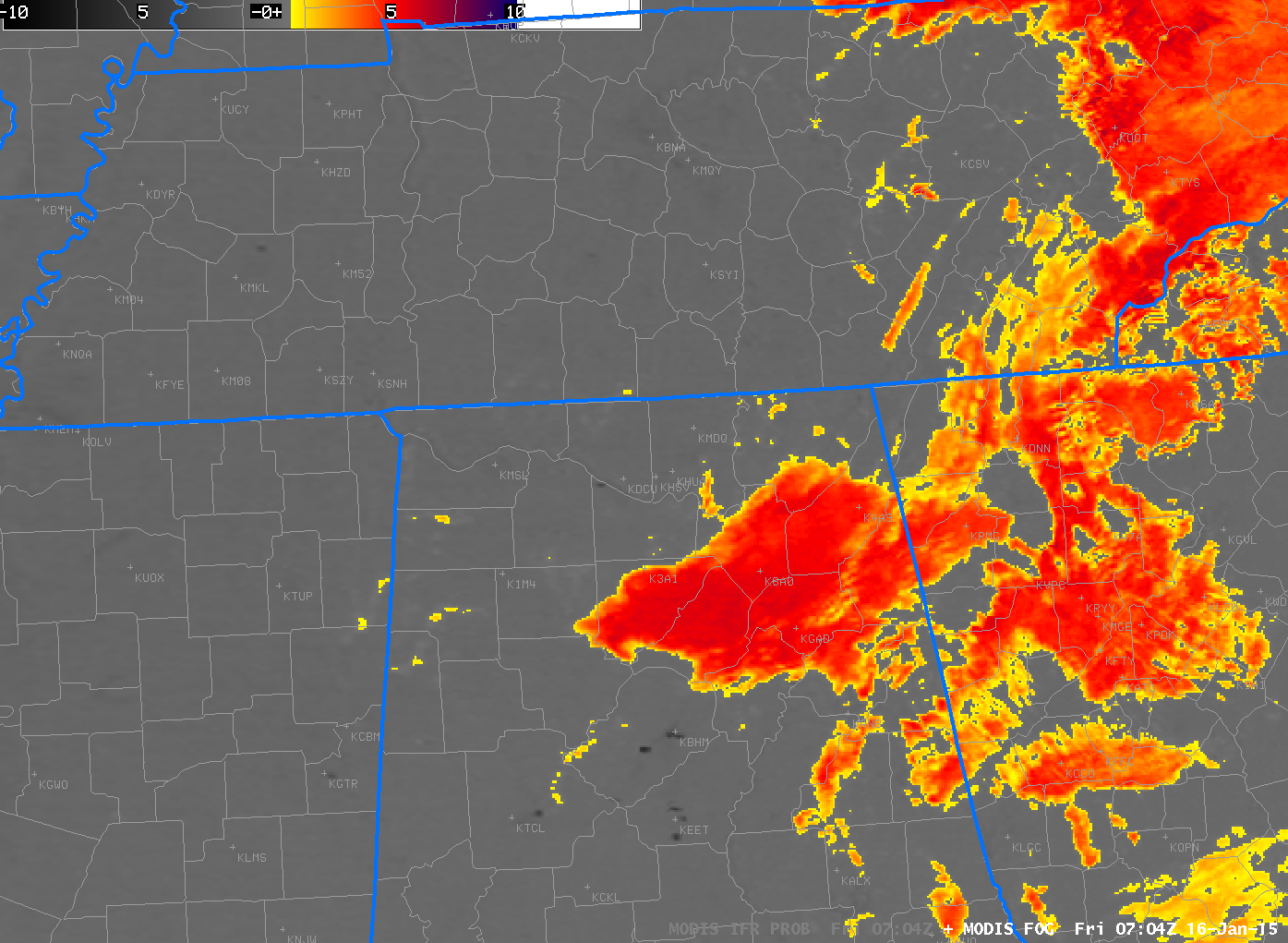
MODIS Brightness Temperature Difference and MODIS-based IFR Probabilities at 0704 UTC on 16 January 2015 (Click to enlarge)
Suomi NPP was positioned such that northern Alabama was viewed on two successive orbits, and the toggle below shows the brightness temperature difference field (11.35 – 3.74). Similar to GOES, Suomi NPP Brightness Temperature Difference fields show the development of water-based clouds in/around Huntsville.
Sharp edge to Fog/Low Stratus over east Texas
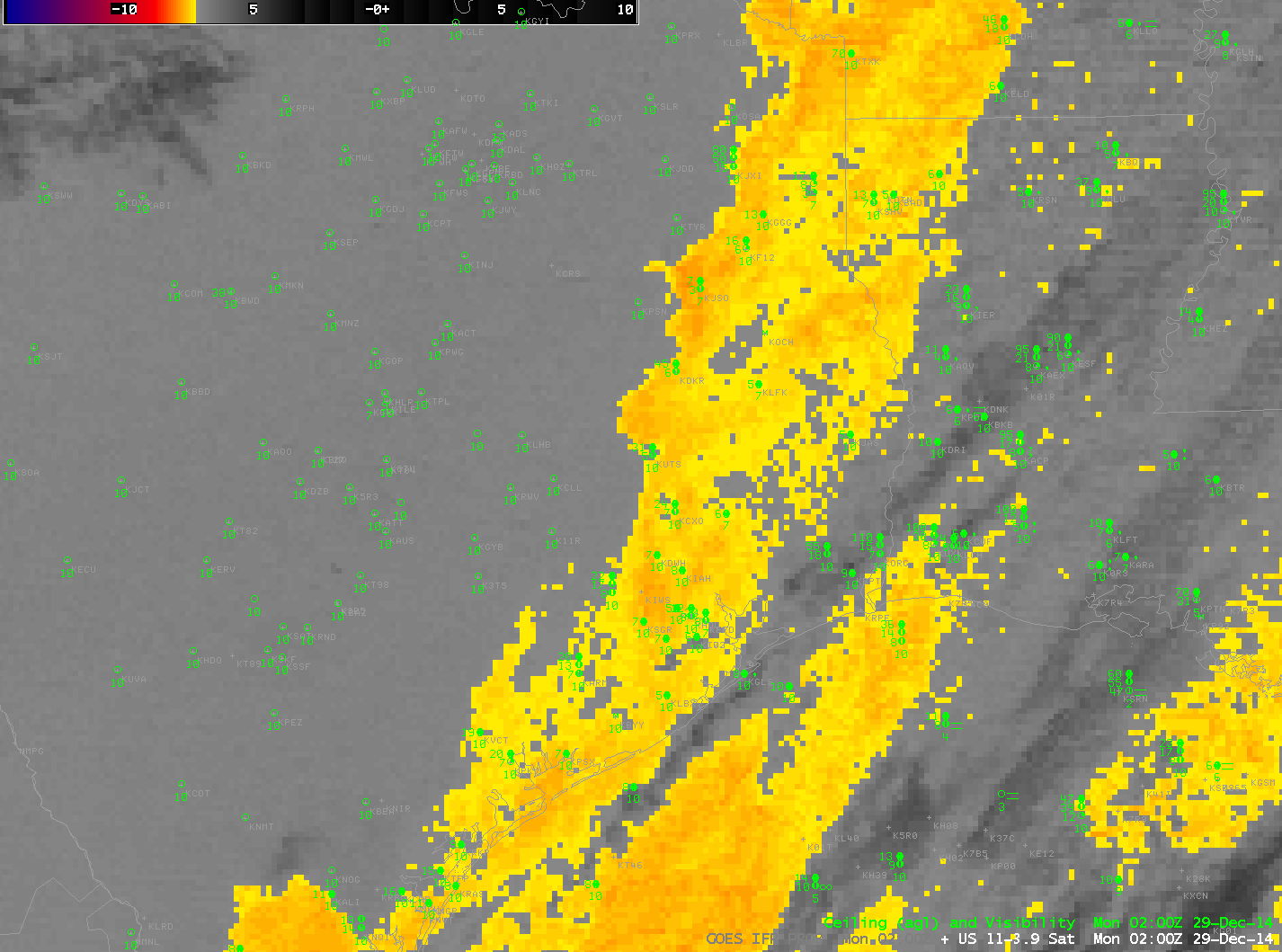
Brightness Temperature Difference Fields (10.7µm – 3.9µm) and surface observations of ceilings and visibilities, Hourly from 0200 through ~1400 UTC [Click to enlarge].
Traditional method of fog/low stratus detection revealed a sharp edge to clouds over east Texas during the morning of 29 December 2014. The animation above reveals several difficulties inherent in using brightness temperature difference fields in diagnosing fog/low stratus. Where multiple cloud layers are present — such as along the coast at 0500-0600 UTC — the brightness temperature difference product cannot view the low clouds. At sunrise, increasing amounts of solar 3.9µm radiation causes the brightness temperature difference product to flip sign. The signal for low clouds is still there, however.
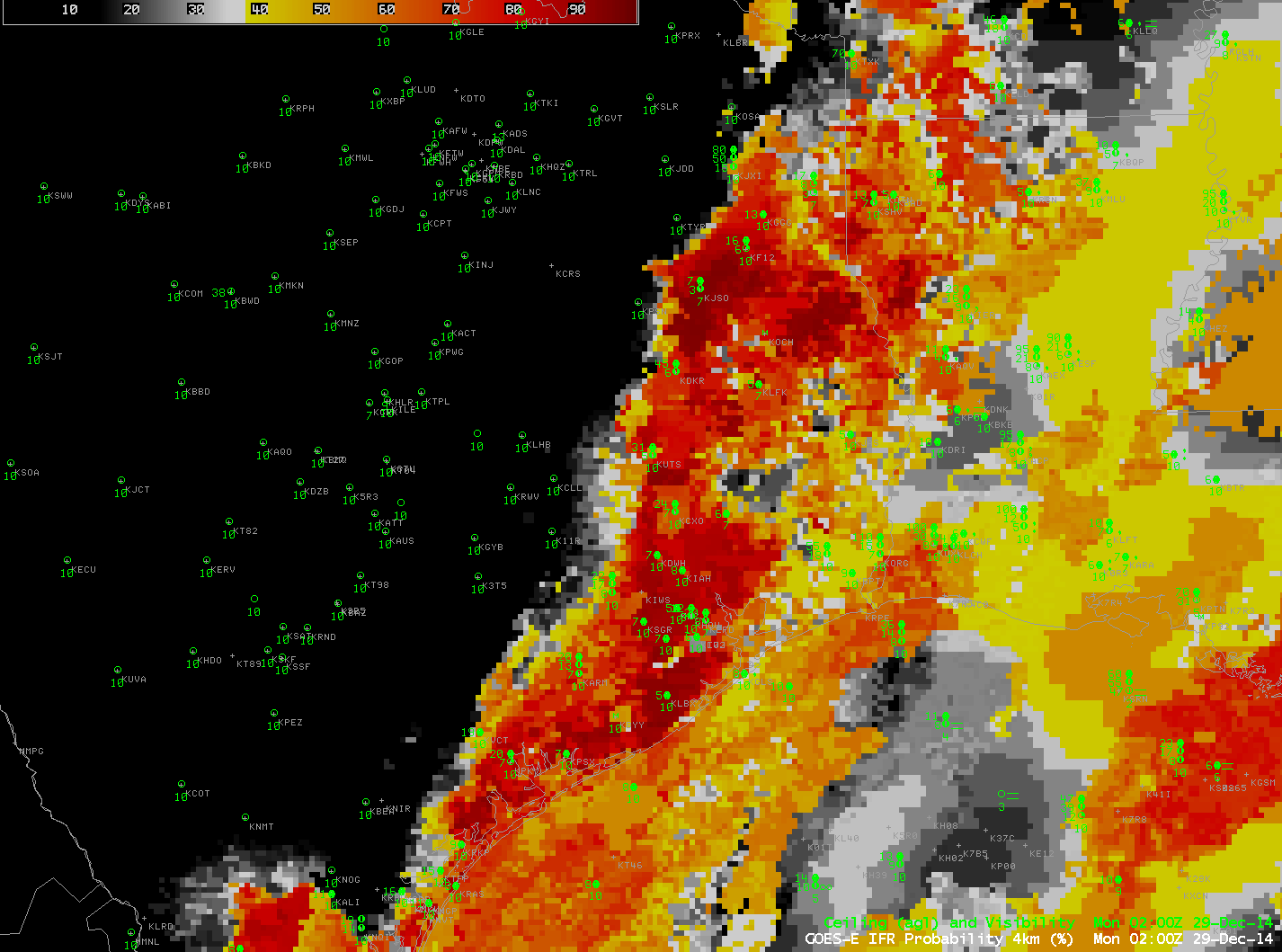
GOES-R IFR Probabilities and surface observations of ceilings and visibilities, Hourly from 0200 through ~1400 UTC [Click to enlarge]
The animation of GOES-R IFR Probabilities, above, created from GOES-13 data and Rapid Refresh Model data, shows high IFR Probabilities over east Texas where low ceilings and reduced visibilities prevailed, including metropolitan Houston. The algorithm suggests the likelihood of fog/low stratus underneath the cirrus debris that is over the coast around 0500-0600 UTC as well, because the Rapid Refresh model output in that region strongly suggests low-level saturation. In addition, the fields show only minor changes through sunrise (the effect of the terminator is present in the final image in the loop).
MODIS data from either Terra or Aqua can be used to produce IFR Probabilities. The data below is from 0442 UTC. Polar orbiter data is infrequent, however, so temporal monitoring of the fog/low clouds is more easily achieved using GOES data. MODIS data, like the GOES data above, shows the effects of cirrus clouds on Brightness Temperature Difference fields and on IFR Probabilities. Cloud predictors of low clouds/fog from satellite cannot be used in regions of cirrus, so IFR Probabilities are smaller in regions where multiple cloud layers exist, which regions are where only Rapid Refresh Data can be used as predictors.
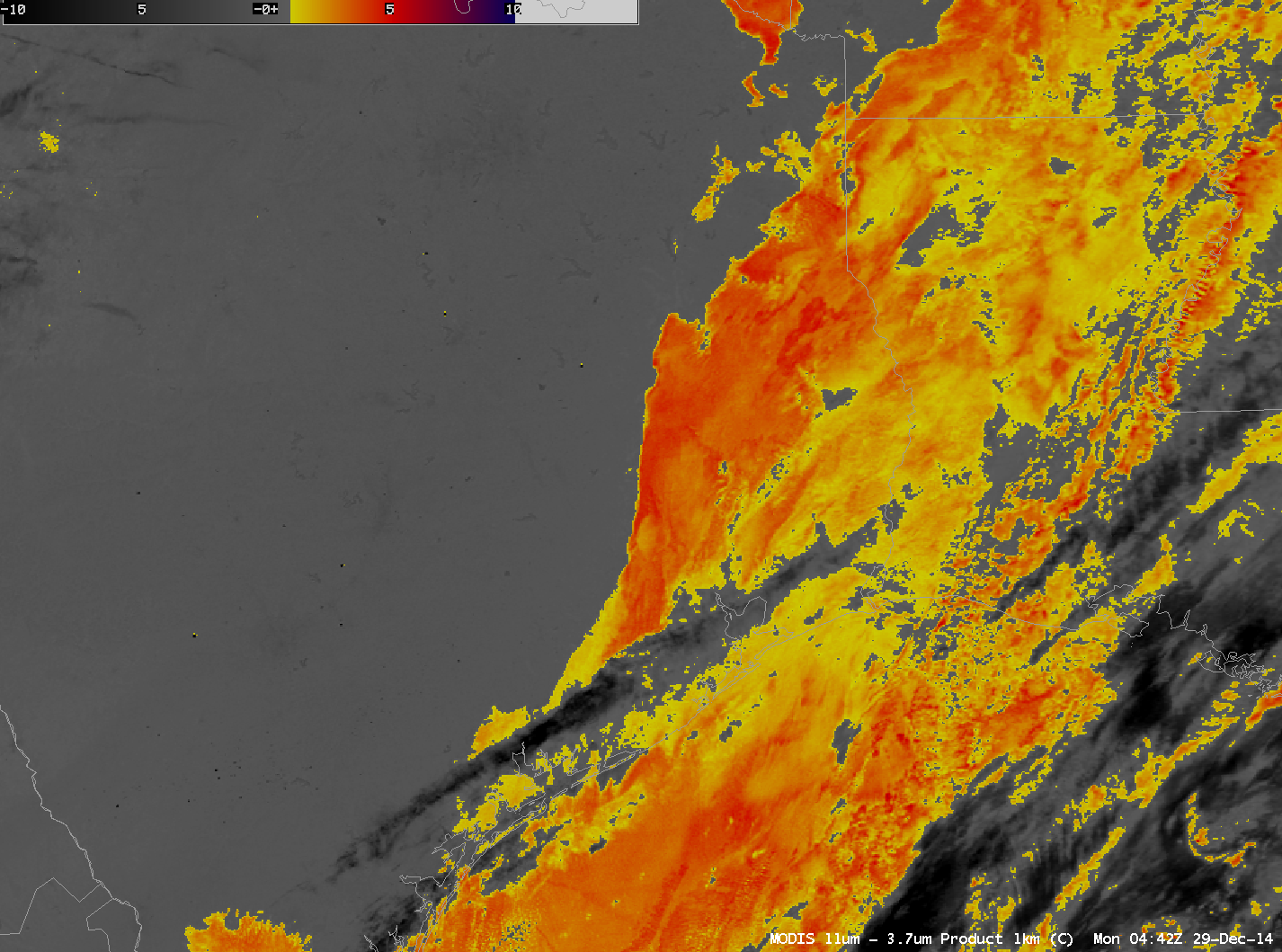
0442 UTC MODIS-based brightness temperature difference and IFR Probability fields (Click to enlarge)
Brightness Temperature Difference fields can also be created from Suomi/NPP data and the orbital geometry on 29 December meant that eastern Texas was viewed on two sequential overpasses. IFR Probabilities are not quite yet computed using Suomi NPP data, but the brightness temperature difference fields can be used to show where water-based clouds exist. They show a very sharp western edge to the clouds.
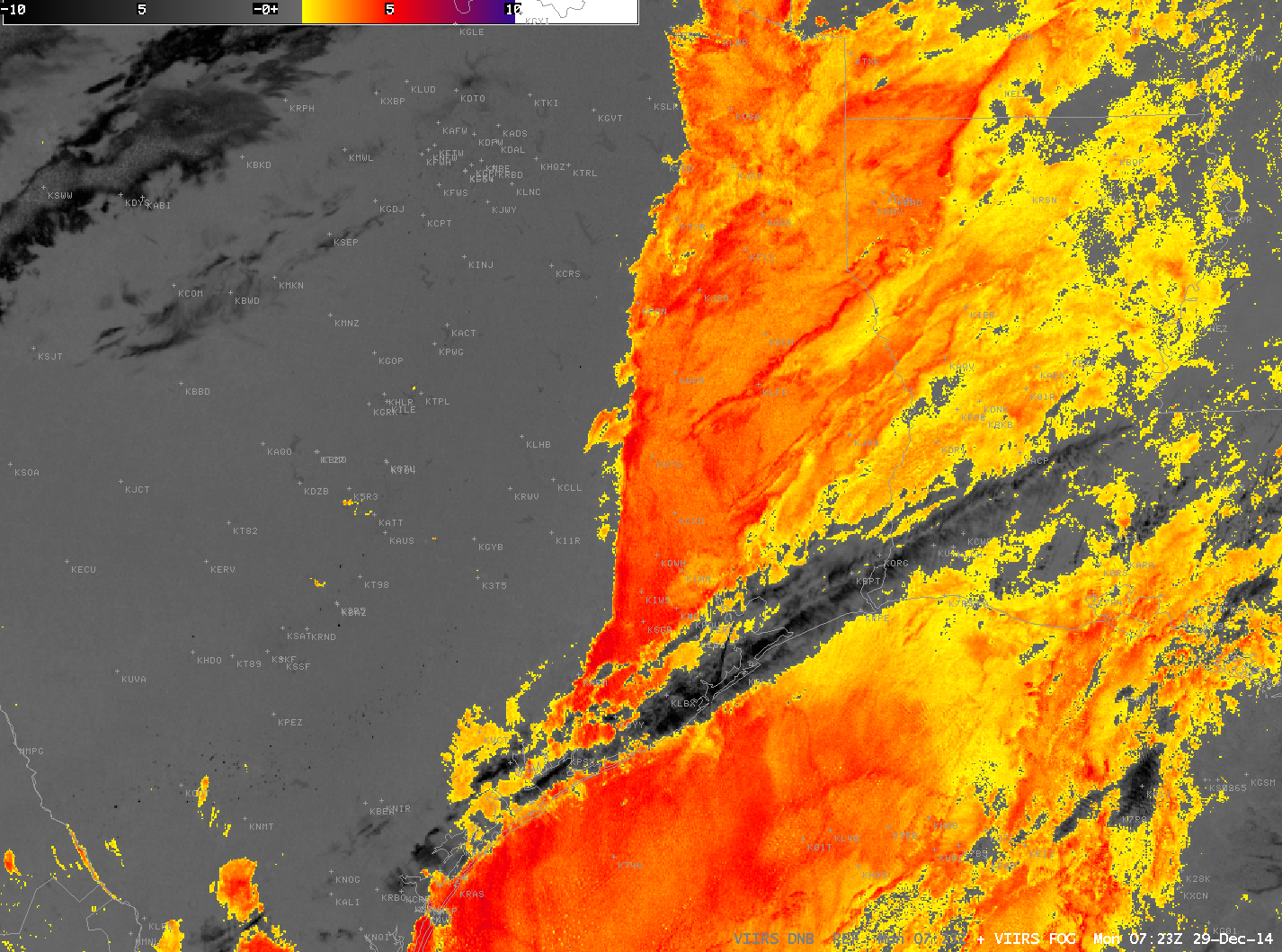
Brightness Temperature Difference Fields (11.35µm – 3.74µm) from Suomi NPP at 0723 and 0904 UTC on 29 December 2014 (Click to enlarge)
The Day Night Band on Suomi NPP produces visible imagery at night. When lunar illumination is strong, it can provide compelling imagery. On 29 December 2014, however, the moon set around 0600 UTC, so no lunar illumination was available, and fog/low clouds are very difficult to discern in the toggle below between the Day Night Band and the brightness temperature difference field at 0723 UTC.

Day Night Band and Brightness Temperature Difference Fields (11.35µm – 3.74µm) from Suomi NPP at 0723 on 29 December 2014 (Click to enlarge)
Dense Fog over South Carolina
Dense fog devloped over South Carolina overnight, in an event that was well-anticipated: From the Charleston, SC, National Weather Service Office AFD (emphasis added):
AREA FORECAST DISCUSSION
NATIONAL WEATHER SERVICE CHARLESTON SC
648 PM EST TUE DEC 2 2014
.SYNOPSIS…
WEAK HIGH PRESSURE WILL PERSIST THROUGH WEDNESDAY. A COLD FRONT
WILL ADVANCE SOUTH THROUGH THE AREA THURSDAY…THEN HIGH PRESSURE
WILL BUILD FROM THE NORTH AND WILL PREVAIL THROUGH FRIDAY. LOW
PRESSURE WILL TRACK THROUGH OR JUST NORTH OF THE REGION SATURDAY…
FOLLOWED BY COLD FRONTS SATURDAY NIGHT AND AGAIN LATE MONDAY.
&&
.NEAR TERM /UNTIL 6 AM WEDNESDAY MORNING/…
A FEW LINGERING STRAY SHOWERS WEST OF I-95 WILL DISSIPATE THIS
EVENING WITH THE ONSET OF NOCTURNAL COOLING AND STABILIZATION.
OUR MAIN FOCUS FOR TONIGHT IS IN REGARDS TO FOG AND THE BUILD DOWN
OF STRATUS…SOME OF WHICH COULD BE DENSE. THE HIGH PRESSURE WEDGE
WILL REMAIN ANCHORED OVER THE INLAND PARTS OF THE SE AS IT
PROGRESSES A LITTLE SOUTHWARD THROUGH THE NIGHT…WITH A WEAK
COASTAL TROUGH OFFSHORE. A STRENGTHENING NOCTURNAL INVERSION WILL
DEVELOP AND TRAP ABUNDANT MOISTURE WITHIN THE PLANETARY BOUNDARY
LAYER UNDERNEATH. THIS WILL LEAD TO THE DEVELOPMENT AND SPREADING
OUT OF FOG AND STRATUS ENCOMPASSING MOST IF NOT ALL OF THE CWFA
DURING THE LATE NIGHT HOURS. BUT ALREADY WE/RE SEEING A FOG BANK
WITH IT/S ORIGINS NORTH OF THE SANTEE RIVER THIS AFTERNOON IS
PROGRESSING SOUTH/SW AND STARTING TO SPREAD A LITTLE INLAND. THIS
IS CLEARLY DEPICTED BY THE 11-3.9 MICRON SATELLITE IMAGERY AS WELL
AS COASTAL METAR SITES. THE COMBINATION OF THE MARINE INDUCED FOG
AND STRATUS WILL COMBINE WITH RADIATION FOG THAT FORMS OVER INLAND
SECTIONS TO RESULT IN AREAS OF FOG ACROSS THE FORECAST ZONES. THE
WORST CONDITIONS WILL BE OVER CHARLESTON COUNTY THIS
EVENING…SPREADING INTO OTHER COASTAL SC ZONES LATER THIS EVENING
AND INTO THE GA COASTAL ZONES BY MIDNIGHT OR SO. INLAND THE BULK
OF THE GREATER FOG/STRATUS COVERAGE WILL WAIT UNTIL WE REACH OUR
CROSS-OVER TEMPS BY 2-3 AM. DENSE FOG ADVISORIES ARE CERTAINLY
POSSIBLE. ANY NEGATING FACTORS AGAINST THE WIDESPREAD DENSE FOG
WOULD BE THE RELATIVELY WARM GROUNDS. BUT GIVEN FOG STABILITY
INDICES IN THE TEENS AND LOWER 20S…MOST PLACES REACHING THEIR
CROSS-OVER TEMPS OF 55-60 AND SOME MARINE FOG WE/D LEAN MORE
TOWARD DENSE FOG BECOMING A CONCERN…THAN NOT.
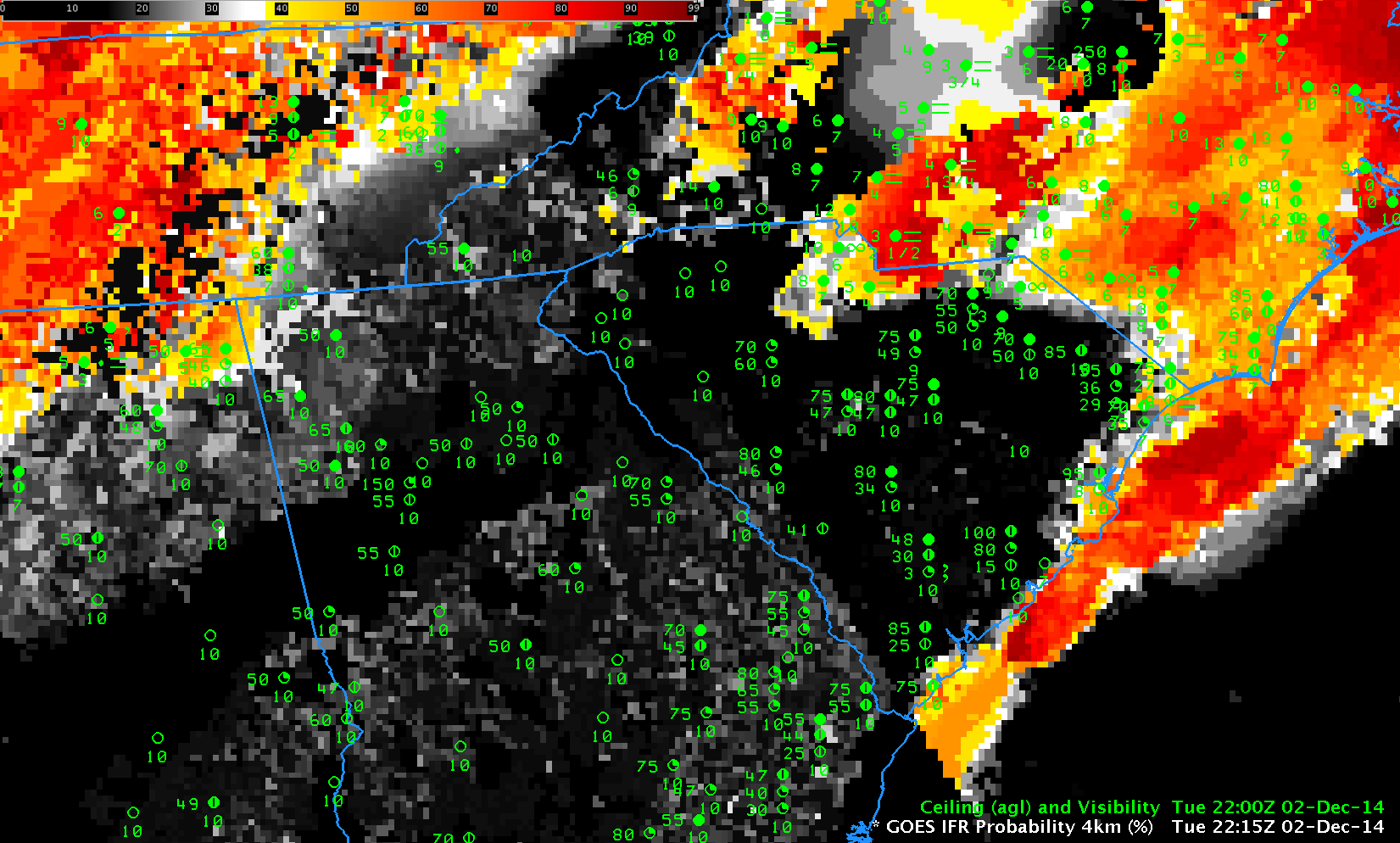
GOES-based GOES-R IFR Probabilities, hourly from 2215 UTC 2 December through 1315 UTC on 3 December as well as observations of ceilings (AGL) and visibilities (Click to enlarge)
The GOES-R IFR Probability fields, shown at hourly intervals above, nicely capture the spread of the extensive fog as the expanding marine fog bank joins up with the developing radiation fog over northwestern South Carolina. (A loop with a shorter dwell rate is here). GOES-13 Brightness Temperature Difference Fields are shown below. (A loop with a shorter dwell rate is here). Brightness Temperature Difference is the traditional method of detecting fog and low stratus, and it is referenced in the AFD above. However, the method cannot operate in regions with high cirrus (such as over Tennessee and northwest South Carolina after 0900 UTC); the brightness temperature difference signal flips sign as the sun rises (as at 1315 UTC in the animation below); the method cannot distinguish between elevated stratus and visibility-restricting fog.
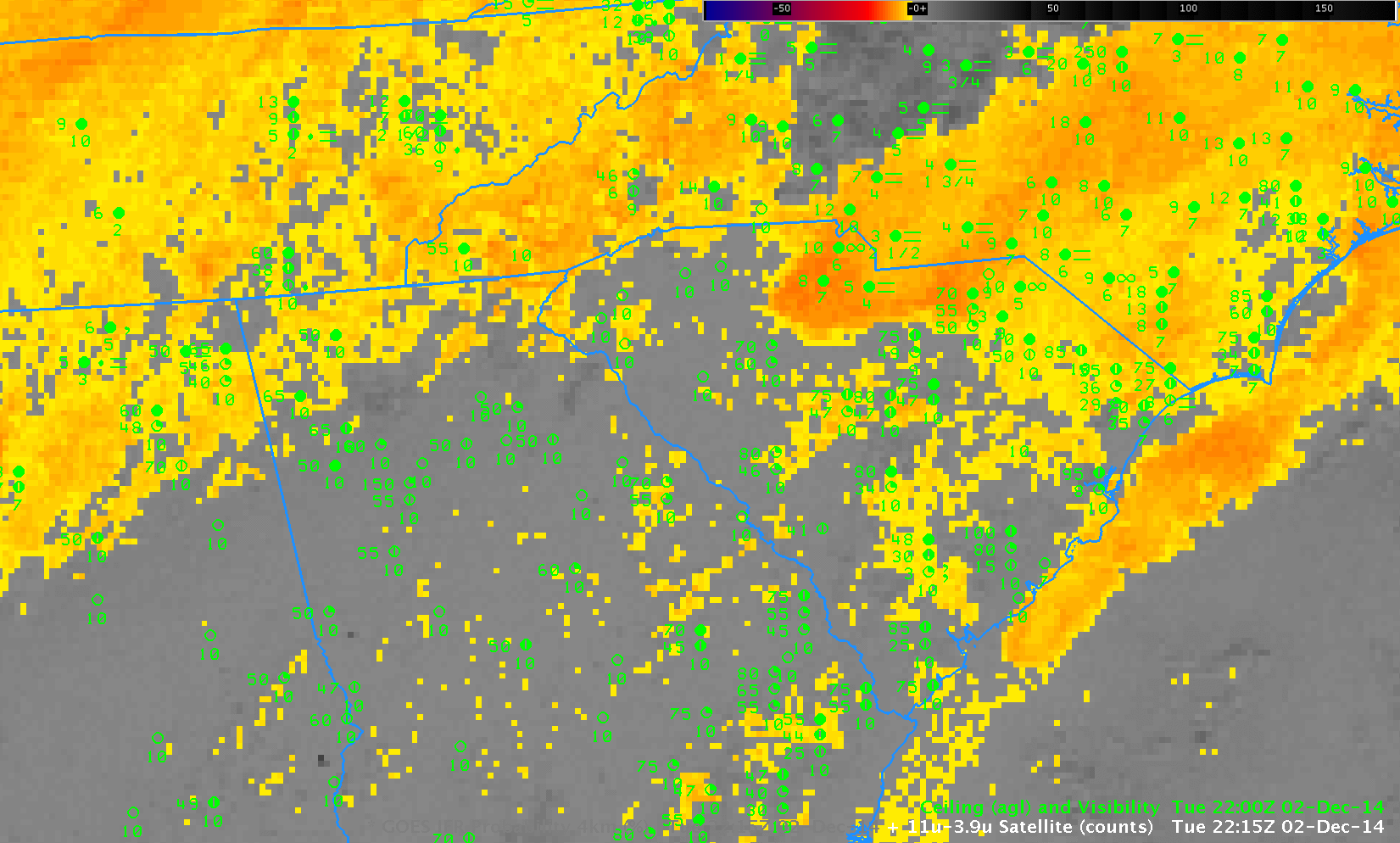
GOES-13 Brightness Temperature Difference Fields (10.7µm – 3.9µm), hourly from 2215 UTC 2 December through 1315 UTC on 3 December, as well as observations of ceilings (AGL) and visibilities (Click to enlarge)
In comparing the two animations, note how the Brightness Temperature Difference field, for example, has strong returns around 0215-0315 UTC over central South Carolina in regions where widespread IFR conditions do not yet exist. In these regions, the Rapid Refresh model data used as a predictor in the GOES-R IFR Probability is not yet showing saturation, so IFR Probabilities aren’t quite so high as they are along the coast. (Click here for a toggle between the GOES-R IFR Probability and the Brightness Temperature Difference fields at 0215 UTC; a toggle at 0315 UTC is here). Note also in the toggles how the IFR Probability fields have little signal over Georgia despite the Brightness Temperature Difference field signal. This demonstrates the power of using fused data products: both the satellite and the model signal must be in accord for very high probabilities to occur.
Low Ceilings/visibilities over the Deep South in the wake of a cold frontal passage
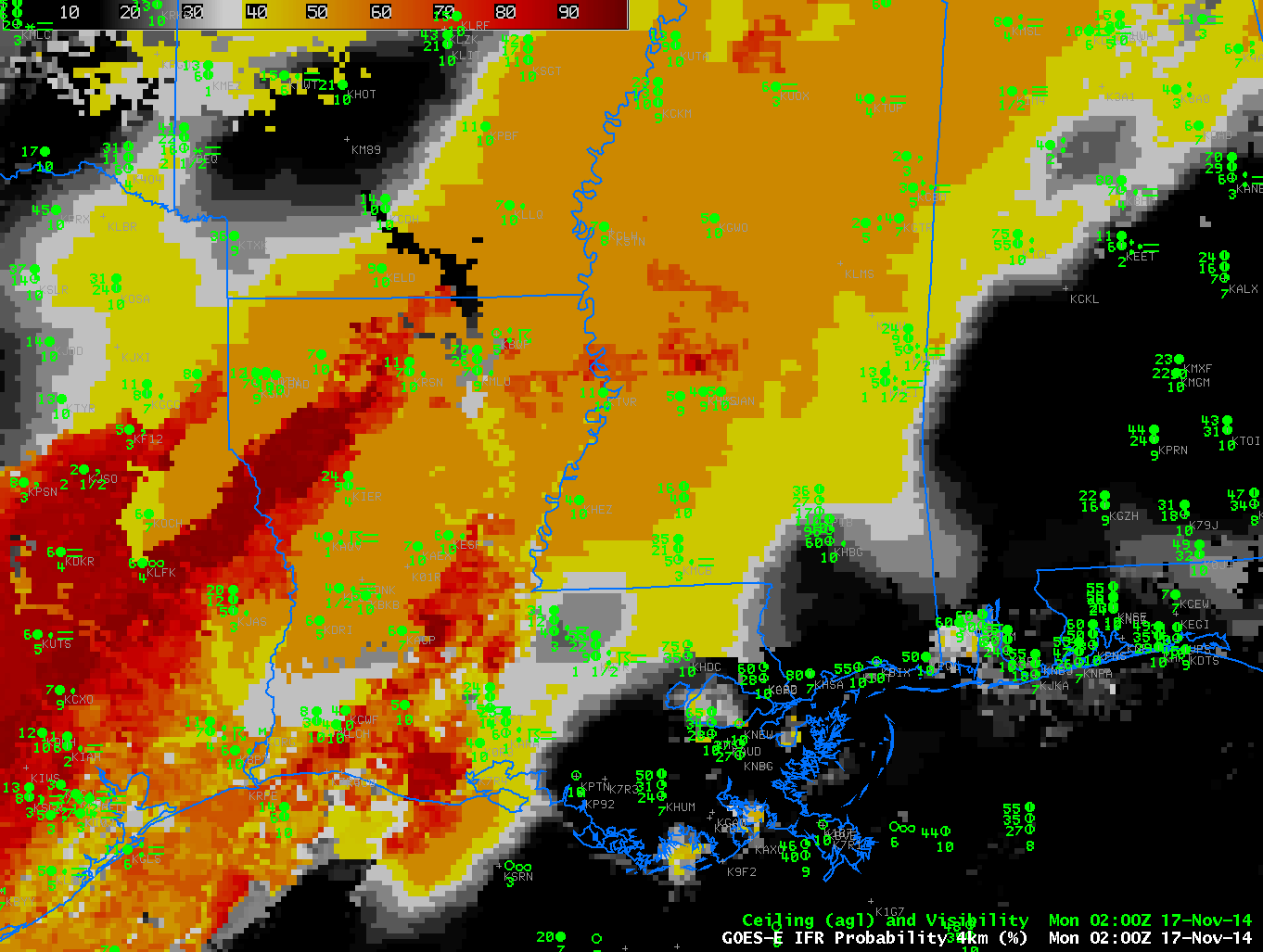
GOES-R IFR Probabilities ~hourly from 0200-1215 UTC on 17 November along with surface plots of ceilings and visibilities (Click to enlarge)
A strong cold front moved through the deep south in the early morning of 17 November 2014, accompanied by low ceilings and reduced visibilities that were very close to IFR conditions. Multiple cloud layers, however, prevented brightness temperature difference fields from diagnosing the low clouds. In cases such as these, a data fusion product such as GOES-R IFR Probability that incorporates surface information via a model simulation (such as the Rapid Refresh) that assimilates surface data is still able to highlight regions where IFR Conditions are most likely. In the animation above, flat fields (those that are horizontally homogeneous, such as over central Mississippi at 0315 UTC) are regions where multiple cloud layers prevent the identification of low cloud features and GOES-R IFR Probability is therefore computed using model-based predictors only. Regions over Louisiana at the beginning of the animation are more pixelated in appearance. This is a region where high clouds have pushed off to the East, where satellites can observe the behavior of low stratus and where satellite data can therefore be used as a predictor in the GOES-R IFR Probability algorithm. Regions where satellite data cannot be used generally have lower probabilities because one of the predictors (satellite data) is absent. That is the case in the above animation. When satellite data can be used, IFR Probabilities increase. Use that knowledge of the behavior of IFR Probability fields to tailor your interpretation of the magnitude of the IFR Probability.
Interpreting IFR Probability Fields

Toggle between GOES-R IFR Probabilities and GOES-East Brightness Temperature Differences (10.7 µm – 3.9 µm) over the southeast US, 0700 UTC 8 September 2014 (Click to enlarge)
When multiple cloud layers are present, such as when a cirrus shield overlays a region, the traditional method of detecting fog/low stratus, the brightness temperature difference product, struggles to identify regions of low clouds because the satellite sees only the signature of the high clouds. Low clouds are hidden from view. In such cases, it is vital to incorporate low-level information to identify regions where fog/low stratus might be present. The required low-level information can come from the model fields of the Rapid Refresh Model. The model predictors can be used to generate IFR Probabilities in regions where satellite predictors are unavailable because of the presence of high clouds.
In the toggle above, the Brightness Temperature Difference field shows high clouds over Georgia and the Carolinas. IFR Probabilities in this region are around 50% — relatively low because Cloud Predictors cannot be used in the algorithm. But IFR Conditions are present over North and South Carolina. Tailor your interpretation of the IFR Probability values to account for which predictors are used.
Over Tennessee, IFR Probabilities are much higher. In this region, satellite predictors can be used, and a strong satellite signal is present. IFR Conditions are not widespread, however. Use the IFR Probability field as one tool (but not the only tool) when making nowcasts about the possibilities of fog/low stratus.
Fog over Mississippi
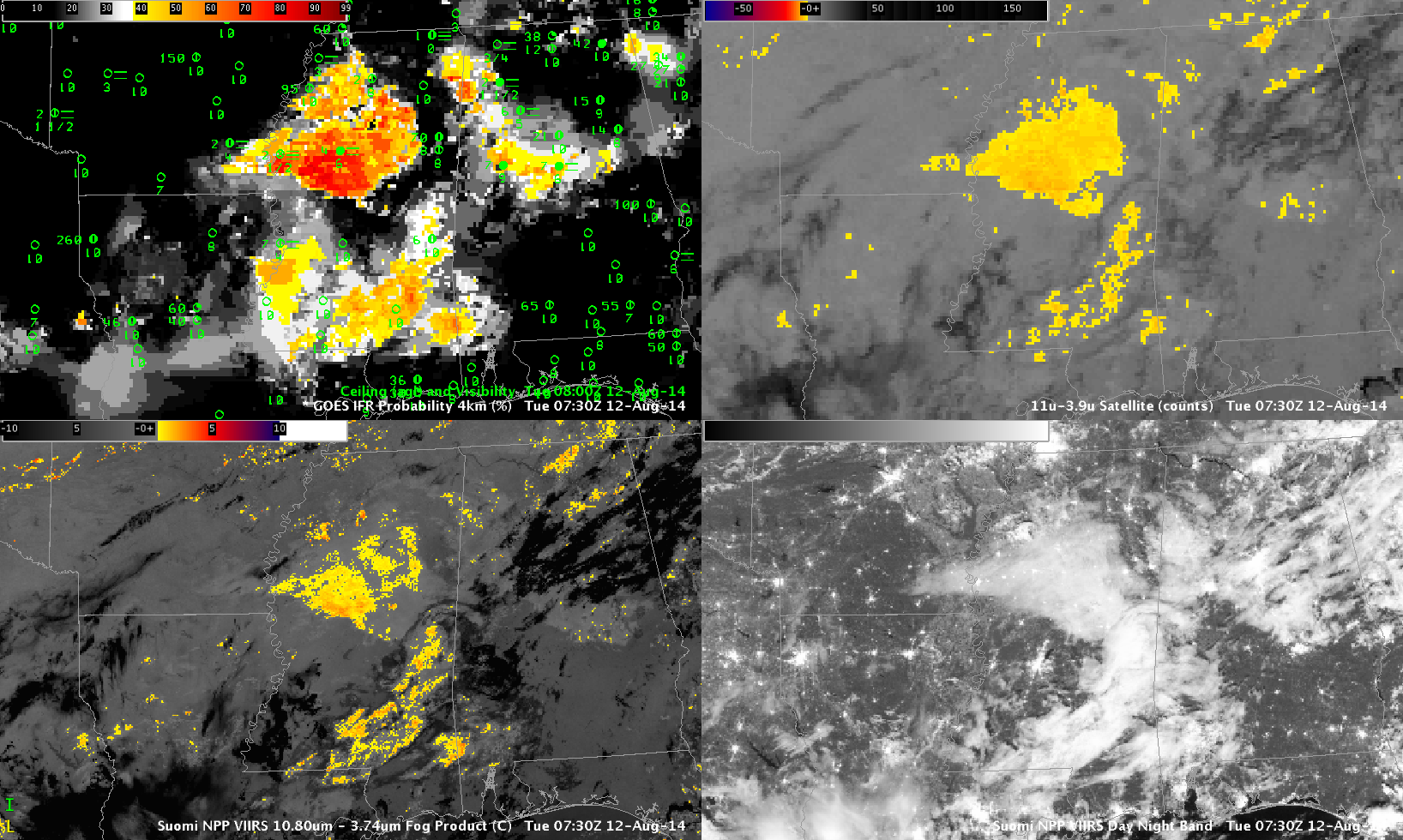
GOES-R IFR Probabilities computed from GOES-13 at 0730 UTC (Upper Left), GOES-13 Brightness Temperature DIfference (10.7 µm – 3.9 µm) (Upper Right), Suomi NPP VIIRS Brightness Temperature Difference (11.35 µm – 3.74 µm) (Lower Left), Suomi NPP VIIRS Day Night Band (Lower Right), all at 0730 UTC on 12 August 2014
Fog developed overnight in central Mississippi, and the imagery above, at 0730 UTC, is a snapshot during the development. The just-past-full moon provided plenty of illumination, so the stratus and cirrus clouds over the south are distinct. It can be difficult, however, using only the Day Night Band to distinguish between low stratus (north-central Mississippi), mid-level stratus (eastern Mississippi), and high, thick cirrus (Alabama). In addition, the Day Night Band and the brightness temperature difference fields give information at the top of the cloud only. Information about the bottom of the cloud — whether the stratus deck extends to the surface as fog, for example, is difficult to glean from cloud-top properties. This is where the IFR Probability field that incorporates both cloud-top features derived from the brightness temperature difference field and lower-tropospheric information extracted from the Rapid Refresh Model can improve the detection of reduced ceilings and visibilities. Suomi NPP and other polar orbiters can give high spatial resolution imagery. GOES data has excellent temporal resolution to monitor how things evolve with time. The animation below shows how the fog/low stratus developed over the course of the day.
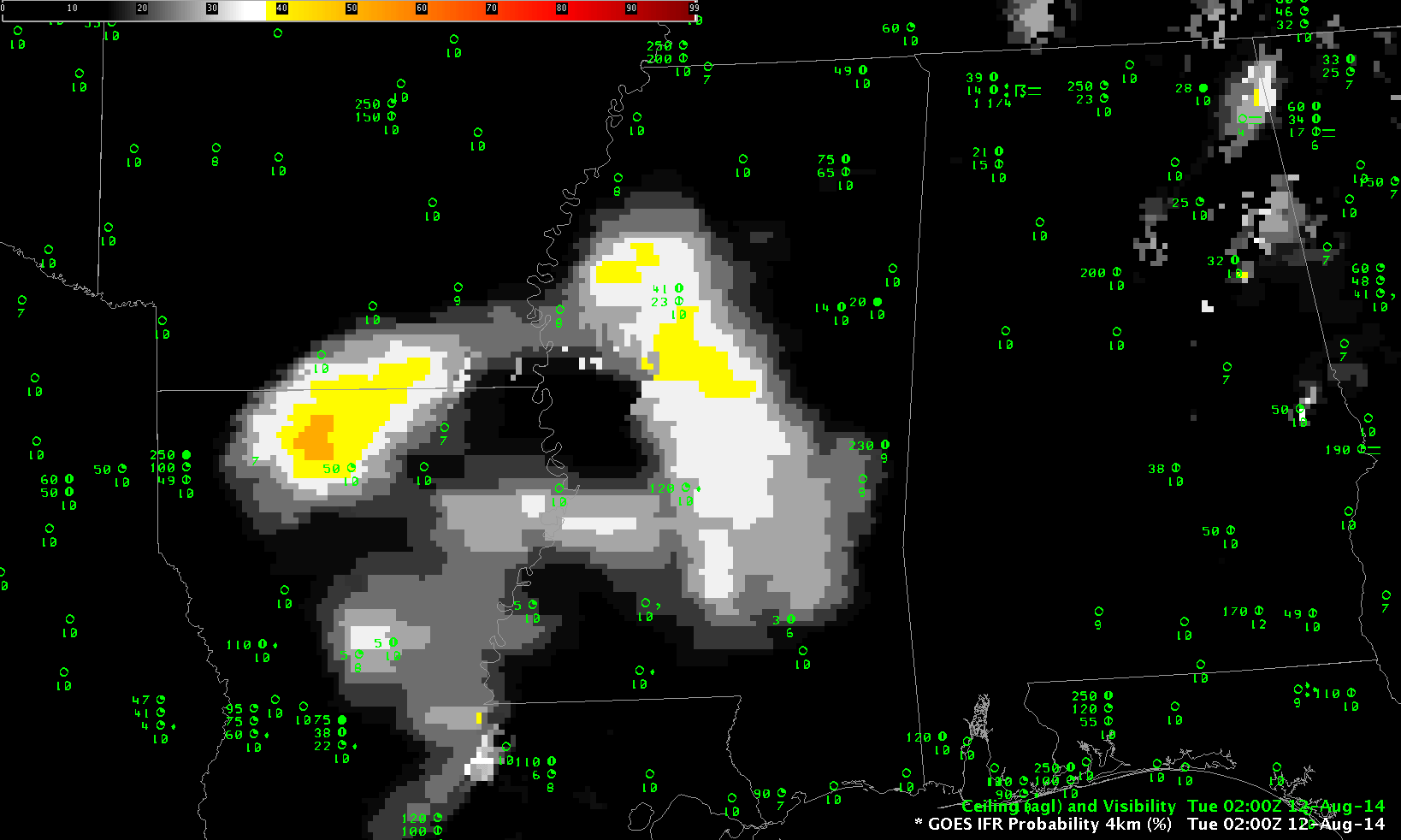
GOES-R IFR Probabilities and Surface observations of visibility/ceilings, hourly 0200-1100 UTC 12 August 2014
The fields in the animation above change character over the course of the night. Initially, the fields over southwestern Mississippi are very smooth; in this region, multiple cloud layers (a thunderstorm complex was dissipating) prevent any satellite signal from being used as a predictor for IFR Probabilities; only model data are being used. As the night progresses and the mid-level and upper-level clouds dissipate, the character of the field takes on a more pixelated appearance that means satellite data are being used as a predictor. The addition of satellite data to the suite of predictors also means that the probability value increases. By the end of the night, high probabilities have overspread much of central Mississippi, and low ceilings and reduced visibilities are widespread.
GOES-R Cloud Thickness can be used to estimate times of fog dissipation, using the relationship in this scatterplot and the Cloud Thickness in the last pre-sunrise scene, shown below for 12 August 2014. The thickest values are near Vicksburg, MS, where GOES-R Cloud Thickness approaches 1000 feet. That suggests a clearing time around 1400 UTC, ~3 hours after the valid time of the image below. The visible animation of the low clouds clearing is below.
Radiation Fog in the Florida Panhandle
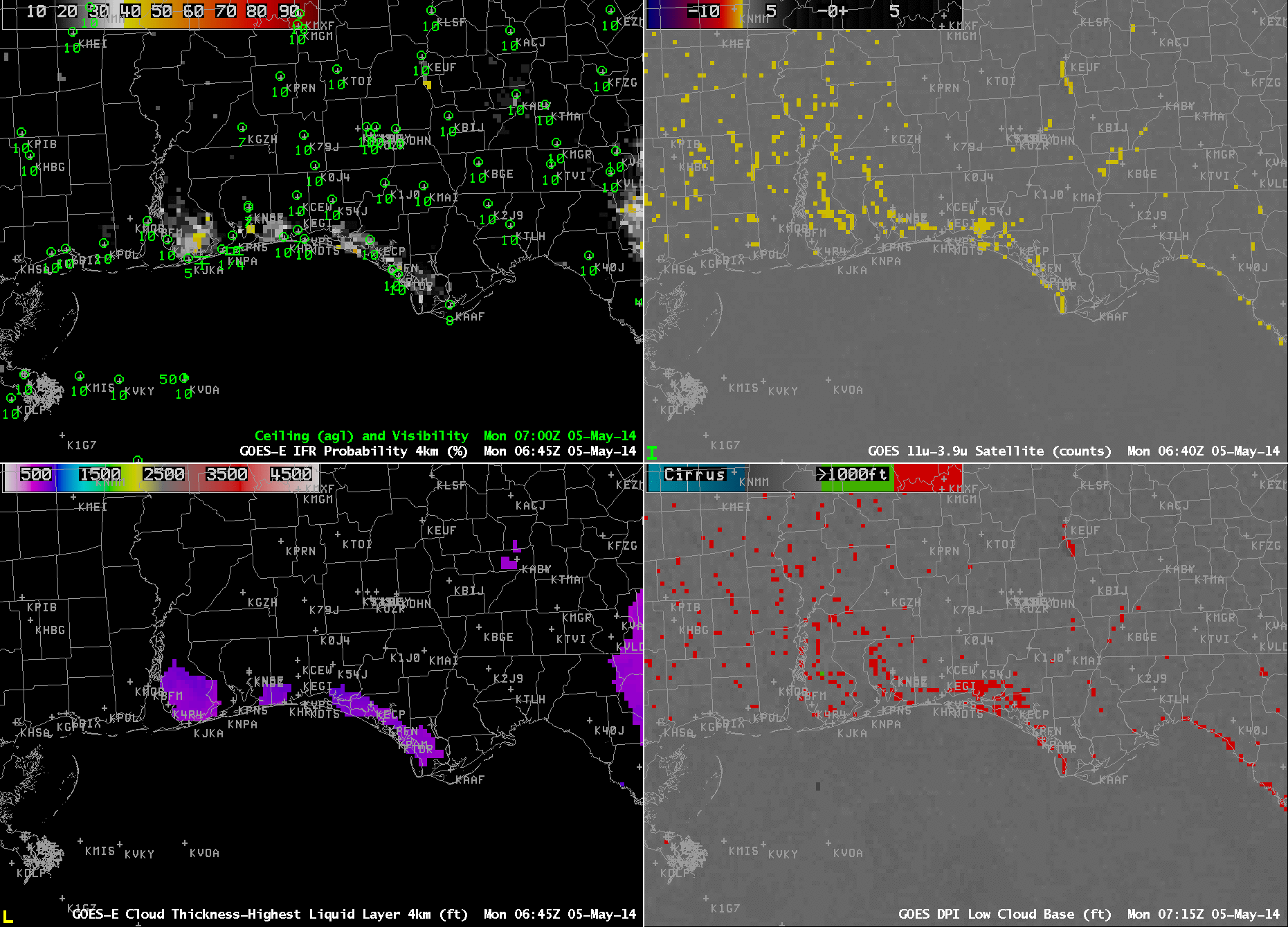
GOES-R IFR Probabilities computed from GOES-East (Upper Left), GOES-East Brightness Temperature Difference (10.7 µm – 3.9 µm) (Upper right), GOES-R Cloud Thickness (Lower Left), GOES-13 Heritage Cloud Thickness Product (Lower Right), times as indicated (Click to enlarge)
Clear skies and light winds over the Florida Panhandle allowed radiation fog to develop, and the GOES-R IFR Probability field ably captured the region of IFR conditions, as shown above. Note how the GOES-R Fields provide information that looks less ‘noisy’: the heritage products — Brightness Temperature Difference and Cloud Thickness — both have signals over interior Alabama and Mississippi where IFR conditions were not reported. In addition, the well-known co-registration error in the 10.7 and 3.9 sensors produces a faulty signal along the Florida coast east of Appalachee Bay. Eventually this signal because so strong that it bleeds into the GOES-R IFR probability.
Cloud thickness can be used to forecast fog dissipation time, using this chart and tempered by experience. The last pre-sunrise cloud thickness is shown at 1045 UTC in the loop above, and is around 1000 feet, suggesting a dissipation time around 1345 UTC. The visible animation below corroborates this estimate.
Fog Dissipation in southern Alabama
GOES-R Fog/Low Stratus products can be used to estimate the time of fog dissipation, an example of which dissipation from 23 April 2014 is shown above (complete with a temporary hole in the subsequent cumulus development). Complete dissipation of the radiation fog occurred by 1632 UTC. This chart is a scatterplot of GOES-R Cloud Thickness in the last pre-sunrise image vs. dissipation time (measured as hours after that pre-sunrise image). The 1100 UTC GOES-R Cloud Thickness is shown below; it is the last pre-sunrise image over Alabama (note that no values are present over Georgia because twilight conditions are present there). GOES-R Cloud Thickness values in the foggy region (where IFR Probabilities are high, and where ceilings are low and visibilities obstructed) are around 1000 feet. Values from the best-fit line at this link suggest, then, a dissipation time of a little over 3 hours, but the spread of values shown in the scatterplot is from less than two hours to more than four. In this present example, fog dissipated after about five hours. IFR conditions ended after about three hours.
Fog in Southwestern Louisiana
Dense fog developed along the I-10 corridor over southern Louisiana during the early morning hours of 21 April 2014. From the AFDs issued by Lake Charles:
000
FXUS64 KLCH 210153
AFDLCH
AREA FORECAST DISCUSSION
NATIONAL WEATHER SERVICE LAKE CHARLES LA
853 PM CDT SUN APR 20 2014
.UPDATE…A WEAK TROF WILL APPROACH FROM THE WEST TONIGHT,
BRINGING A LIGHT SOUTHERLY FLOW AND SOME MOISTURE NEAR THE SURFACE.
THIS MOISTURE SHOULD BE SUFFICIENT FOR THE FORMATION OF PATCHY
GROUND FOG LATER TNITE…WHICH IS ALREADY IN THE FORECAST.
The 319 AM CDT Forecast Discussion noted the increase in IFR Probabilities:
000
FXUS64 KLCH 210819
AFDLCH
AREA FORECAST DISCUSSION
NATIONAL WEATHER SERVICE LAKE CHARLES LA
319 AM CDT MON APR 21 2014
.DISCUSSION…
MID AND HIGH LEVEL CLOUDS STREAMING ACROSS INTERIOR SOUTHEAST
TEXAS…OTHERWISE…TEMPERATURES MAINLY IN THE UPPER 50S TO LOWER 60S
AREAWIDE. CLEAR SKIES AND LIGHT WINDS SETTING UP AGAIN FOR FOG
DEVELOPMENT MAINLY ALONG THE I-10 CORRIDOR FROM BEAUMONT EAST TO
SHORT OF LAFAYETTE LOUISIANA. GOES-E/MODIS MVFR PRODUCT SHOWING
INCREASING PROBABILITY OF LOW VISIBILITY FOR DEVELOPING IN THE
BPT AREA WHICH LATEST OBSERVATION CONFIRM THAT TREND…AND ANOTHER
AREA FROM LAKE CHARLES TO NEAR LAFAYETTE. THEREFORE…ASKING FOLKS
TO DRIVE CAREFULLY THIS MORNING IF YOUR DRIVING IN THESE AREAS.
Shortly after sunrise, a Dense Fog Advisory was issued:
000
FXUS64 KLCH 211150
AFDLCH
AREA FORECAST DISCUSSION
NATIONAL WEATHER SERVICE LAKE CHARLES LA
650 AM CDT MON APR 21 2014
.UPDATE…
ISSUED DENSE FOG ADVISORY FOR THE I-10 CORRIDOR AREA FROM
SOUTHEAST TEXAS TO LAKE CHARLES TO LAFAYETTE. MAIN CONCERN WAS
LIGHT WINDS AND STRONG RADIATIONAL COOLING WHICH HAS RESULTED IN
A SHARP DROP IN VISIBILITIES OVER A SHORT TIME PERIOD. DENSE FOG
MAY BOUNCE UP AND DOWN A BIT DURING THE ADVISORY TIMES. DENSE FOG
SHOULD DISIPATE BY 9 AM.
How did the IFR probability forecasts do during this event? At 0400 UTC (below), neither the IFR probabilities nor the traditional method of fog/low cloud detection suggest fog/low clouds are present.
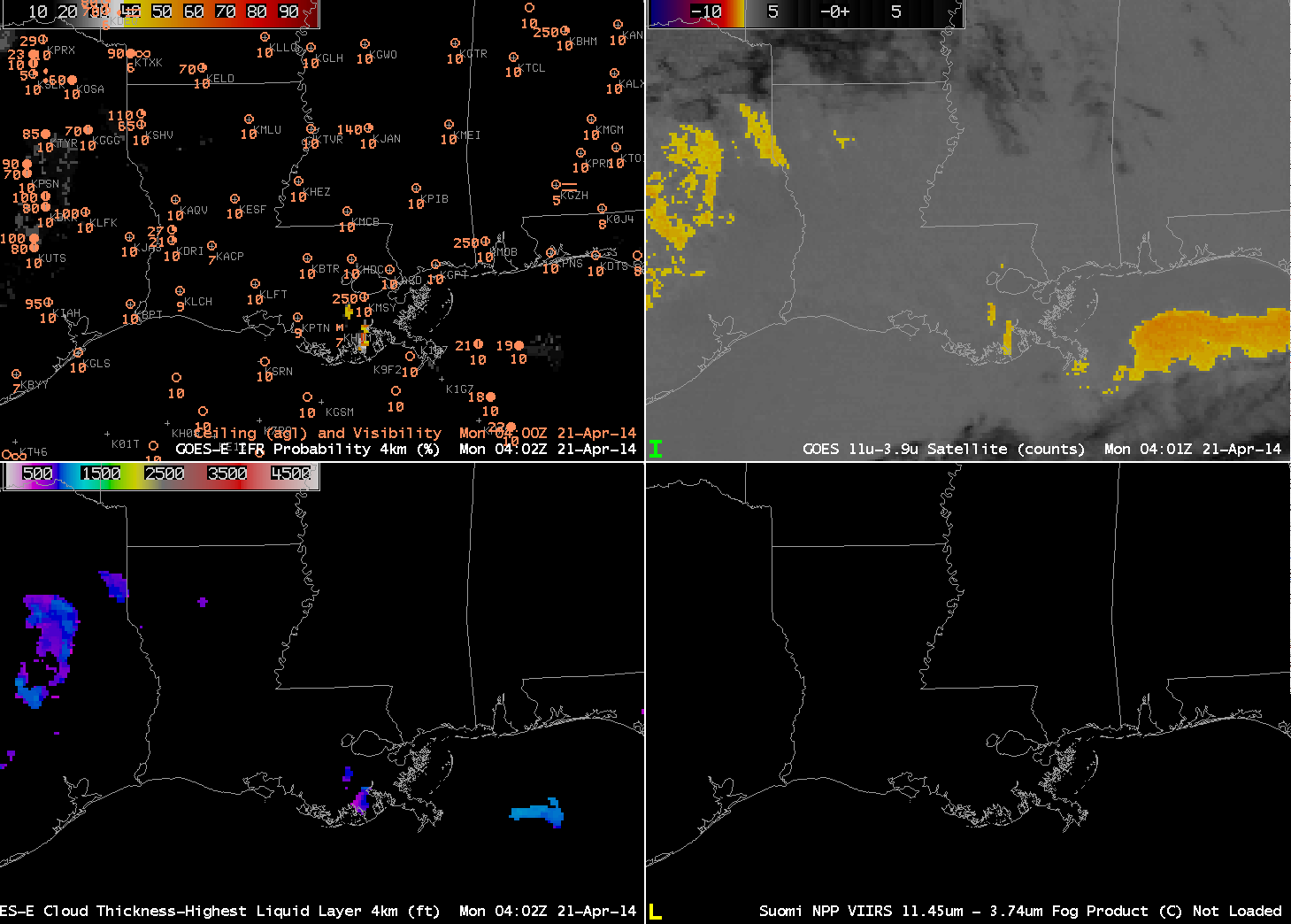
GOES-R IFR Probabilities computed from GOES-East (Upper Left), GOES-East Brightness Temperature Differences (10.7 µm – 3.9 µm) (Upper Right), GOES-R Cloud Thickness (Lower Left), Suomi/NPP VIIRS Brightness Temperature Difference (11 µm – 3.74 µm) (Lower Right), 0400 UTC on 21 April 2014 (click to enlarge) (click to enlarge)
By 0600 UTC, IFR Probabilities have increased to around 10% in/around Lake Charles as visibilities have dropped. GOES-R Cloud Thickness values are around 600 feet.
Just before 0800 UTC, a Suomi/NPP overpass provided high-resolution data. Neither the GOES-East nor the VIIRS data brightness temperature difference products show a distinct fog/stratus signal over southwestern Louisiana, where GOES-R Cloud Thickness values persist at around 600 feet, and where IFR probabilities have increased past 50%.
By 1100 UTC (below), when the Dense Fog Advisory is issued (hours after the IFR Proabilities first increased), the Brightness Temperature Difference product from GOES-East is finally showing a faint (albeit noisy) signal of fog/low stratus over southwestern Louisiana. A stronger signal extends northeast and southwest from Baton Rouge.



